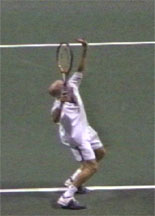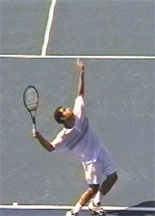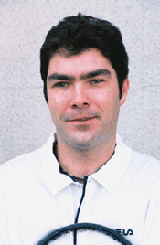Researching the Serve
By Greg Ryan
Movement scientists who have studied tennis over the last two decades have made the serve a focus for biomechanical analysis. There are two reasons why more analysis has been done of the serve compared to the other strokes.
First, the serve is probably the most important stroke in tennis. It begins every point and is the only stroke in which the player has complete control.
The second reason is that the serve is much easier to film and therefore to analyze. This is because the players serve from set positions on the court. filming for three-dimensional analysis is generally done with fixed cameras that can't pan or zoom to follow the players. The wide range of court movement in groundstrokes and net play makes the other strokes far more difficult to study.
The work of movement scientists has attempted to identify and to quantify the central elements in the motions of elite servers. The results to date show that the motions of elite servers are extremely complex--an opinion certainly shared by most working coaches. The performer must coordinate the motion of multiple body segments very precisely to produce a high racquet velocity and an optimal swing path as well orient the racket head at ball impact.
In this article we'll take a look at the scientific literature to date, reviewing and summarizing what is currently known. To do this we will break the serve down into a series of 5 major phases, each of which has been the subject of a greater or lesser number of quantitative studies.
We'll discuss what is currently best understood and least understood about the serve. This will lay the ground work for introducing a new body of three dimensional work that was undertaken as a collaboration between the human movement laboratory at San Francisco State, Dr. Robert Schliehauf, myself, and Advanced Tennis Research. (www.advancedtennis.com). In future articles we'll be presenting some of these results, not only regarding the serve, but other strokes as well.
The 5 Phases of the Serve are: The Tossing Phase The Backswing Phase The Loading Phase The Acceleration Phase The Followthrough Phase |
The Tossing Phase
The initial phase of the serve begins with the movement of the arms and ends with the ball leaving the hand. This is the ball toss phase. The goal of this phase is to toss the ball consistently to a desired location that is optimal for ball contact and the timing of the stroke.
This aspect of the serve has not been well researched, with a limited number of investigators identifying the critical aspects. Studies to date show, however, that there is a high degree of variability within the tosses of elite servers. The positioning of the body, the height of the toss, as well as the left to right position of the toss all seem to vary substantially from elite performer to elite performer.
Some studies have found elite subjects begin with their shoulders in alignment with the direction of the serve and with the majority of their weight on the front foot. But qualitative observation of players at any pro events shows that this is far from the only option. Players have a wide range of starting positions with different shoulder alignments, and with the weight distributed differently over either or both feet.
Toss Height
The height of the ball toss depends on the timing or temporal aspect of the performers' backswing. A performer with a slow backswing will need to have a higher toss than a player with a faster and/or abbreviated backswing.
Another factor that influences this timing is the amount of ball drop from maximum height. Studies have shown that virtually all elite performers studied contact the ball after it has begun to drop from its apex. This is true even for players with lower tosses, such as Greg Rusedski or Goran Ivanisevic.
An increase in drop height increases the velocity of the ball at impact. This increases the margin of error in striking the ball on the racquet's sweet spot. It also increases the amount of topspin that will be imparted on the ball with all other aspects being equal.
Only one study has identified the characteristics of the actual tossing arm motion of elite players. The professional players sampled all tossed the ball with their arm completely straight (elbow extended). This identifies the shoulder joint as the prime mover of the arm, while the elbow is in a fixed position.
The actual point of the release of the ball was slightly lower than the standing height of the performer. This seems to be a control strategy that maximizes accuracy and consistency, since very little force is required to toss the ball to the desired location.
Path of the Toss
Another factor is the path of the ball after it leaves the tossing hand. On the first serve, all participants tossed the ball from the right to the left.
In fact, the research shows that the tosses of professional players could move up to three feet to the left, after the release. In addition, top players also tossed the ball in front of their bodies, again up to three feet forward of the point at which the toss was released.
This finding contradicts a coaching myth that has promoted a straight up and down toss or a toss that is to the right of the body of a right handed server. A case study showed that the contact point in selected professional player was about six inches to the LEFT of the player's left toe.
But again qualitative observation of elite servers indicates that the precise amount of movement from right to left varies significantly and may also be related to the amount and type of spin produced.
The Backswing Phase
The next phase of the serve is the backswing phase. This phase overlaps with the tossing phase, with the player positioning the racquet at the same time he is executing the toss.
The Backswing Phase ends when the racquet tip reaches its maximum vertical distance from the ground or the court.
 |
 |
 |
 |
Research shows the Checkmark position is optimal for the drive to the ball. |
|||
The goal of this phase is to position the body segments and racquet in an optimal position for the drive to the ball. Researchers have identified the end of this phase as the so-called "checkmark" position, where the tossing arm, shoulder segment and upper arm are in line at approximately 45 degrees with the dominant elbow flexed. Both qualitative and quantitative studies have shown that elite technique varies minimally at this position.
Studies have identified two backswing techniques, both of which lead to the
"checkmark" position. In the full backswing, the player first drops the racquet towards the
ground by letting the elbow joint extend, a motion which is gravity assisted. The shoulder
then moves away from the body (technically called "abduction") with the elbow extended.
The movement of the racquet is in a circular path upward and away from the ground.
The elbow then flexes approximately 90 degrees at the same time the tossing
arm reaches its maximal position creating the "checkmark". This backswing pattern,
considered to be classic or old school by most coaches, is characteristic of players
such as John McEnroe or Mark Philippoussis.
The other backswing technique that has been identified is the abbreviated backswing. In the abbreviated backswing, the player keeps the elbow flexed from the starting position to the end of the backswing.
The movement is generated from the shoulder joint, with two key movements. The first is "abduction" in which the shoulder moves away from the body. The second is external rotation. This is the rotation of the upper arm backwards in the shoulder joint until the checkmark position is achieved.
Players with versions of the abbreviated backswing include Pete Sampras, who has a mildly abbreviated backswing, and Andy Roddick, who is known for the most extreme version of this variation.
Lower Body
The lower body during the backswing phase can also vary considerably from performer to performer. These differences can include the position of the legs at the beginning of the serve, and the distribution and movement of the weight between the legs.
The common characteristic in elite servers is that the center of gravity moves forward as the arms rise. As the center of gravity shifts forward both knees flex. But the flex varies in magnitude between performers.
Two techniques have been identified in positioning the feet, the "foot-back" and "foot-up" methods. In the foot-back technique the dominant or rear foot remains stationary as the center of gravity shifts forward and the knees flex.
The foot-up method is characterized by the back foot sliding forward usually until it is next to the front foot during the backswing. One study conducted on college level players focused on comparing these techniques and concluded that the foot-up method resulted in a higher contact position while the foot-back technique increased contact position in the forward direction and increased the amount the body traveled into the court.
Hips and Shoulders
The hip and shoulder segments have been shown to rotate to the right
(for a right handed player) during the backswing phase. The movements in this phase
result in the body being rotated to the right of the target with the tossing elbow fully
extended and the shoulder abducted (which moves the arm away from the body) so that the
hand is above the level of the head.
The dominant elbow is flexed approximately 90 degrees with the shoulder
abducted approximately 90 degrees as well. The hitting arm is also externally rotated
(or rotated backward in the shoulder joint) about 90 degrees.
The dominant shoulder is at a lower vertical position that the non-dominant
shoulder with both of the knees flexed. The body is now in an optimal position to drive
to the ball as the body moves into the loading phase of the serve.
The Loading Phase
The Loading Phase of the serve begins as the legs extend to propel the body toward the ball. The Loading Phase ends as the racquet drops behind the back to its lowest point.
The goal of this phase is to load or place the muscles of the upper-extremity on stretch and increase the range of motion of the path that the racquet makes to the ball. Placing a muscle on stretch maximizes its capacity to produce force. An increase in range of motion of the shoulder and elbow gives the player more space to accelerate the racket.




